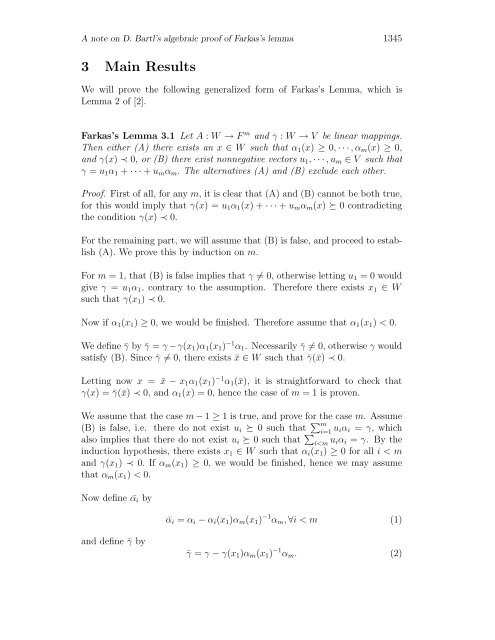A Note on D. Bartl's Algebraic Proof of Farkas's Lemma 1 Introduction
A Note on D. Bartl's Algebraic Proof of Farkas's Lemma 1 Introduction
A Note on D. Bartl's Algebraic Proof of Farkas's Lemma 1 Introduction
Create successful ePaper yourself
Turn your PDF publications into a flip-book with our unique Google optimized e-Paper software.
A note <strong>on</strong> D. Bartl’s algebraic pro<strong>of</strong> <strong>of</strong> Farkas’s lemma 1345<br />
3 Main Results<br />
We will prove the following generalized form <strong>of</strong> Farkas’s <strong>Lemma</strong>, which is<br />
<strong>Lemma</strong> 2 <strong>of</strong> [2].<br />
Farkas’s <strong>Lemma</strong> 3.1 Let A : W → F m and γ : W → V be linear mappings.<br />
Then either (A) there exists an x ∈ W such that α 1 (x) ≥ 0, ···,α m (x) ≥ 0,<br />
and γ(x) ≺ 0, or (B) there exist n<strong>on</strong>negative vectors u 1 , ···,u m ∈ V such that<br />
γ = u 1 α 1 + ···+ u m α m . The alternatives (A) and (B) exclude each other.<br />
<strong>Pro<strong>of</strong></strong>. First <strong>of</strong> all, for any m, it is clear that (A) and (B) cannot be both true,<br />
for this would imply that γ(x) =u 1 α 1 (x)+···+ u m α m (x) ≽ 0 c<strong>on</strong>tradicting<br />
the c<strong>on</strong>diti<strong>on</strong> γ(x) ≺ 0.<br />
For the remaining part, we will assume that (B) is false, and proceed to establish<br />
(A). We prove this by inducti<strong>on</strong> <strong>on</strong> m.<br />
For m = 1, that (B) is false implies that γ ≠ 0, otherwise letting u 1 = 0 would<br />
give γ = u 1 α 1 , c<strong>on</strong>trary to the assumpti<strong>on</strong>. Therefore there exists x 1 ∈ W<br />
such that γ(x 1 ) ≺ 0.<br />
Now if α 1 (x 1 ) ≥ 0, we would be finished. Therefore assume that α 1 (x 1 ) < 0.<br />
We define ¯γ by ¯γ = γ −γ(x 1 )α 1 (x 1 ) −1 α 1 . Necessarily ¯γ ≠0, otherwise γ would<br />
satisfy (B). Since ¯γ ≠0, there exists ¯x ∈ W such that ¯γ(¯x) ≺ 0.<br />
Letting now x = ¯x − x 1 α 1 (x 1 ) −1 α 1 (¯x), it is straightforward to check that<br />
γ(x) =¯γ(¯x) ≺ 0, and α 1 (x) =0, hence the case <strong>of</strong> m = 1 is proven.<br />
We assume that the case m − 1 ≥ 1 is true, and prove for the case m. Assume<br />
(B) is false, i.e. there do not exist u i ≽ 0 such that ∑ m<br />
i=1 u iα i = γ, which<br />
also implies that there do not exist u i ≽ 0 such that ∑ i
















